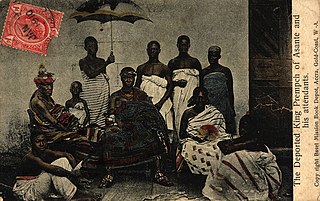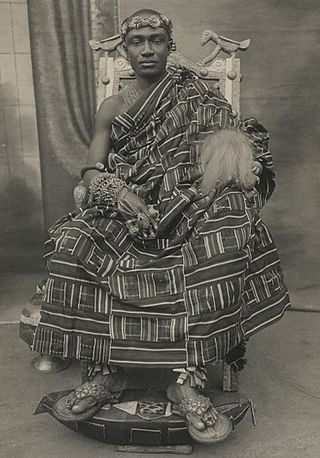Yaa Asantewaa I was the Queen Mother of Ejisu in the Ashanti Empire, now part of modern-day Ghana. She was appointed by her brother Nana Akwasi Afrane Okese, the Edwesuhene, or ruler, of Edwesu. In 1900, she led the Ashanti war also known as the War of the Golden Stool, or the Yaa Asantewaa War of Independence, against the British Empire.

Osei Tutu II is the 16th Asantahene, enstooled on 26 April 1999. By name, Otumfuo Osei Tutu II is in direct succession to the 17th-century founder of the Ashanti Empire, Otumfuo Osei Tutu I. He is also the Chancellor of the Kwame Nkrumah University of Science and Technology. A Freemason, Otumfuo Osei Tutu II has served as the Grand Patron of the Grand Lodge of Ghana, the Sword Bearer of the United Grand Lodge of England and the Grand Patron of the Grand Lodge of Liberia.

The Ashanti Region is located in the southern part of Ghana and is the third largest of 16 administrative regions, occupying a total land surface of 24,389 km2 (9,417 sq mi) and making up 10.2 percent of the total land area of Ghana. It is the most populated region in Ghana, with a population of 5,440,463 according to the 2021 census, accounting for around one-sixth of Ghana's total population. The Ashanti Region is known for its gold bar and cocoa production. The largest city and capital of Ashanti is Kumasi.

The Golden Stool is the royal and divine throne of kings of the Asante people and the ultimate symbol of power in Asante. According to legend, Okomfo Anokye, High Priest and one of the two chief founders of the Asante Confederacy, caused the stool to descend from the sky and land on the lap of the first Asante king, Osei Tutu. Such seats were traditionally symbolic of a chieftain's leadership, but the Golden Stool is believed to house the spirit of the Asante nation—living, dead and yet to be born.

The Anglo-Ashanti wars were a series of five conflicts that took place between 1824 and 1900 between the Ashanti Empire—in the Akan interior of the Gold Coast—and the British Empire and its African allies. The wars were mainly due to Ashanti attempts to maintain and enforce their imperial control over the coastal areas of present-day Ghana, where peoples such as the Fante and the Ga had come under the protection of the British. Although the Ashanti emerged victorious in some of these conflicts, the British ultimately prevailed in the fourth and fifth conflicts, resulting in the complete annexation of the Ashanti Empire by 1900.
Articles related to Ghana include:

The War of the Golden Stool, also known as the Yaa Asantewaa War, the Third Ashanti Expedition, the Ashanti Uprising, or variations thereof, was a campaign in 1900 during the series of conflicts between the United Kingdom and the Ashanti Empire, an autonomous state in West Africa that fractiously co-existed with the British and its vassal coastal tribes.

The Asante Empire, also known as the Ashanti Empire, was an Akan state that lasted from 1701 to 1901, in what is now modern-day Ghana. It expanded from the Ashanti Region to include most of Ghana and also parts of Ivory Coast and Togo. Due to the empire's military prowess, wealth, architecture, sophisticated hierarchy and culture, the Asante Empire has been extensively studied and has more historic records written by European, primarily British, authors than any other indigenous culture of sub-Saharan Africa.
In many parts of West Africa, there is an old chieftaincy tradition, and the Akan people have developed their own hierarchy, which exists alongside the democratic structure of the country. The Akan word for the ruler or one of his various courtiers is "Nana". In colonial times, Europeans translated it as "chief", but that is not an exact equivalent. Other sources speak of "kings", which is also not entirely correct, especially in the case of the said courtiers. The term "chief" has become common even among modern Ghanaians, though it would be more correct to use the expression "Nana" without translation wherever possible.

Prempeh I was the thirteenth king ruler of the Ashanti Empire and the Oyoko Abohyen Dynasty. King Prempeh I ruled from March 26, 1888 until his death in 1931, and fought an Ashanti war against Britain in 1895-6.

The Yaa Asantewaa Museum is a museum in Ejisu Municipal District in the Ashanti Region of Ghana. It was built to honor Ashanti leader Yaa Asantewaa, who was the queen mother of Ejisu.

The Manhyia Palace is the seat of the Asantehene, as well as his official residence. It is located in Menshyia, Kumasi, the capital of the Ashanti Region of Ghana. The first palace is now a museum. Otumfuor Opoku Ware II built the new palace, which is close to the old one and is where the current Asantehene, Otumfuor Osei Tutu II, resides.

Prempeh II, was the 14th Asantehene, or king of the Ashanti, reigning from 22 June 1931 to 27 May 1970.

Offinso, is a town in the Offinso Municipality in the Ashanti Region of Ghana. The town is about fifteen minutes drive from Kumasi, the capital of the Ashanti Region; due to Offinso's proximity to Kumasi, many of the Offinso natives have relocated to Kumasi.
Yaa Asantewaa Girls' Senior High School (YAGSHS) is a public high school for girls in Tanoso in the Atwima Mponua District in Kumasi in the Ashanti Region of Ghana.
Yaa Akyaa was an Asantehemaa of the Ashanti Empire in 1884-1896. She had great influence during the reign of her son, and acted as his de facto co-regent.
Ivor Agyeman-Duah is a Ghanaian academic, economist, writer, editor and film director. He has worked in Ghana's diplomatic service and has served as an advisor on development policy.
Nana Dokua was the queen mother of Akyem Abuakwa. She was the one who welcomed the King of the Dwabens called Nana Kwaku Boateng and his army. A civil war broke out between the Ashantis and the Dwabens in 1832, six years after the battle of Akatamansu. In 1824, during her regime, she also provided refuge for the Kotokus who had also assisted Abuakwa in some wars against the Ashantis. During her reign, part of the Juabens revolted against the Ashantis. Nana Kwaku Boateng was the leader of the rebels who was their chief. They were forced to leave Juaben in Ashanti for the south.
Nana Kwabena Wiafe also known as Nana Kwabena Wiafe Ababio or, in private life, Kwabena Sanwo Ansah, was a traditional ruler and Omanhene of Offinso Traditional Area. He is known to be the first Offinso royal to be enstooled twice in Offinso history. He reigned from 1935 to 1945 and from 1959 to 1966.
Asantewaa: Battle for the Golden Stool is a 3D Animation directed by Jesse Sunkwa-Mills.










